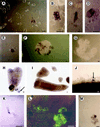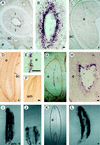Expression pattern of the carrot EP3 endochitinase genes in suspension cultures and in developing seeds
- PMID: 9576773
- PMCID: PMC35020
- DOI: 10.1104/pp.117.1.43
Expression pattern of the carrot EP3 endochitinase genes in suspension cultures and in developing seeds
Abstract
Carrot (Daucus carota) extracellular protein 3 (EP3) class IV endochitinases were previously identified based on their ability to rescue somatic embryos of the temperature-sensitive cell line ts11. Whole-mount in situ hybridization revealed that a subset of the morphologically distinguishable cell types in embryogenic and nonembryogenic suspension cultures, including ts11, express EP3 genes. No expression was found in somatic embryos. In carrot plants EP3 genes are expressed in the inner integumentary cells of young fruits and in a specific subset of cells located in the middle of the endosperm of mature seeds. No expression was found in zygotic embryos. These results support the hypothesis that the EP3 endochitinase has a "nursing" function during zygotic embryogenesis and that this function can be mimicked by suspension cells during somatic embryogenesis.
Figures






Similar articles
-
Characterization of chitinases able to rescue somatic embryos of the temperature-sensitive carrot variant ts 11.Plant Mol Biol. 1996 Jun;31(3):631-45. doi: 10.1007/BF00042235. Plant Mol Biol. 1996. PMID: 8790295
-
cDNA cloning of ECP40, an embryogenic-cell protein in carrot, and its expression during somatic and zygotic embryogenesis.Plant Mol Biol. 1993 Mar;21(6):1053-68. doi: 10.1007/BF00023602. Plant Mol Biol. 1993. PMID: 8490126
-
Expression pattern of the Arabidopsis thaliana AtEP3/AtchitIV endochitinase gene.Planta. 2001 Mar;212(4):556-67. doi: 10.1007/s004250000464. Planta. 2001. PMID: 11525512
-
Somatic Versus Zygotic Embryogenesis: Learning from Seeds.Methods Mol Biol. 2016;1359:25-46. doi: 10.1007/978-1-4939-3061-6_2. Methods Mol Biol. 2016. PMID: 26619857 Review.
-
Positional cues and differential gene expression in somatic embryos of higher plants.Cell Differ Dev. 1990 Jun;30(3):159-69. doi: 10.1016/s0922-3371(90)80001-2. Cell Differ Dev. 1990. PMID: 2207838 Review.
Cited by
-
Host-microbiota-insect interactions drive emergent virulence in a complex tree disease.Proc Biol Sci. 2020 Aug 26;287(1933):20200956. doi: 10.1098/rspb.2020.0956. Epub 2020 Aug 19. Proc Biol Sci. 2020. PMID: 32811286 Free PMC article.
-
AtCSLA7, a cellulose synthase-like putative glycosyltransferase, is important for pollen tube growth and embryogenesis in Arabidopsis.Plant Physiol. 2003 Feb;131(2):547-57. doi: 10.1104/pp.014555. Plant Physiol. 2003. PMID: 12586879 Free PMC article.
-
Characterization of a tissue-specific and developmentally regulated beta-1,3-glucanase gene in pea (Pisum sativum).Plant Mol Biol. 2002 May;49(2):171-86. doi: 10.1023/a:1014910900312. Plant Mol Biol. 2002. PMID: 11999373
-
A microarray approach to identify genes involved in seed-pericarp cross-talk and development in peach.BMC Plant Biol. 2011 Jun 16;11:107. doi: 10.1186/1471-2229-11-107. BMC Plant Biol. 2011. PMID: 21679395 Free PMC article.
-
A distinct member of the basic (class I) chitinase gene family in potato is specifically expressed in epidermal cells.Plant Mol Biol. 1999 Apr;39(6):1137-51. doi: 10.1023/a:1006178425803. Plant Mol Biol. 1999. PMID: 10380801
References
-
- Bewley JD, Black M (1994) Seeds: Physiology of Development and Germination, Ed 2. Plenum Press, New York
-
- Borthwick HA. Development of the macrogametophyte and embryo of Daucus carota. Bot Gaz. 1931;92:23–44.
-
- Bulawa CE, Wasco W. Chitin and nodulation. Nature. 1991;353:710. - PubMed
-
- Cox KH, Goldberg RB. Analysis of plant gene expression. In: Shaw CH, editor. Plant Molecular Biology: A Practical Approach. Oxford, UK: IRL Press; 1988. pp. 1–34.
LinkOut - more resources
Full Text Sources
Other Literature Sources

